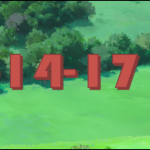The Wandering Witch – Gnawing on God Eater

Welcome, all, again. This time our topic is God Eater, set in 2071 as humanity fights creatures born of research gone awry. God Eater originated as a game for Playstation Portable(R) and has had several incarnations as such. Light novel and manga adaptations also appeared, finally leading to an anime from Ufotable. I was at first uninterested in watching, due to the series’ heavy reliance upon CGI; I prefer the softer contours of traditionally drawn anime. Additionally, and despite this being an action-driven show, the CGI often lags. Strong storylines and focus upon character development eventually won the day, however, and I have become a fan. Still, I would warn on the front end that there is plenty of blood and the occasional gore, so I must advise against younger viewers.
The anime begins with protagonist Lenka Utsugi entering the fortified city of Fenrir. The world outside–from which Lenka comes–is ravaged by creatures of varying size and shape known collectively as Aragami, or violent gods. In reality, however, each Aragami is actually a colony of single-cell organisms acting as a collective whole, in much the same way as does coral. And so Aragami as encountered by humans are “superorganisms” controlled by a core which acts as both a unifying force and brain. This makes them hard to kill, necessitating the removal of the core from the body. And only certain people, known as God Eaters, are able to control the weapons which do this, called God Arcs. Lenka is one such person, and for that reason is allowed to enter Fenrir, wherein he begins training to fight Aragami while awaiting his God Arc’s construction. Having survived on his own, however, Lenka has difficulty adapting to the concepts of teamwork and orders. He had best learn quickly!
Lenka wants to protect others from the Aragami, and his desperate eagerness to kill them suggests some rather tragic backstory. He is committed to his combat training but persists in acting individually, thus inspiring mistrust from superiors and already active fighters. He epitomizes the undisciplined prodigy. And when Aragami breach Fenrir’s defenses and enter the city, Lenka disobeys orders and rushes into the fight with his untested God Arc. Which he has never used before. Which he has not yet even been taught to use. Which will probably make a mighty fine toothpick for the Aragami that eats him. And so Lenka’s first truly successful lesson is how to make deer-in-the-headlights eyes. But something, somewhere, works, and Lenka’s God Arc awakens. Lenka joins the fray in earnest, saving and being saved, finally able to fight the monsters he hates. His God Arc stuns everyone–Lenka included–when it changes of its own accord from blade into gun, identifying Lenka as a New-Type God Eater. New-Types, able to transform their weapons to meet immediate needs, are extremely rare and valuable to the developing strategies against the Aragami. The actual worth of that value, however, waits to be tested when Lenka is set to be court-martialed for disobeying orders and joining combat.
The main storyline continues to follow this general pattern: mission deployment, combat, return, debriefing. And all the while, Lenka learns more about this new society and his place within it. Fenrir is a city under siege, subject to the fears, shortages, and restrictions common to that situation. (Women’s clothing seems especially scarce!) A Spartan attitude pervades–only the strong are welcome and accepted; the desolation outside awaits those deemed unworthy. But a secondary storyline is visited at the end of each episode, chronicling the discovery and development of Oracle cells, those single-cell organisms which eventually evolve into the Aragami. And this briefly viewed backstory is perhaps more brutal and chilling than the main. The research on these newly discovered cells is quickly hijacked by personal egos, funding concerns, and governmental controls. First viewed as a potential energy source, then as a kind of living Play-Doh(R), Oracle cells quickly prove themselves beyond containment and control. (A metaphor for the humanity whom they overwhelm, perhaps?)
God Eater is great entertainment, if somewhat gruesome at times. There is a hovering sense of desperation that lends credence to the plot and setting–the viewer is easily transported into the situation. Characters are introduced, developed, and their motivations explored in a surprisingly unhurried way, given the frenzied action of the series. And that action, while not exactly non-stop, is intense when it occurs. Choices are encountered and made, and the consequences made clear afterwards. And if those choices are heart-wrenching, then the consequences are often gut-wrenching. Like a fairy tale, God Eater offers a surface story with many deeper layers of meaning, allowing the viewer to decide how deep to go. God Eater presently airs on Crunchyroll on Tuesdays at 12:00pm CDT (with episodes 10-13 being delayed in their original release).



![God-Eater-Hulu-Header[1]](http://918thefan.com/wp-content/uploads/2015/10/God-Eater-Hulu-Header1-300x169.jpg)
![Alisas-a-bitch-770x442[1]](http://918thefan.com/wp-content/uploads/2015/10/Alisas-a-bitch-770x4421-300x172.jpg)
![God-Eater[1]](http://918thefan.com/wp-content/uploads/2015/10/God-Eater1-300x169.jpg)
![bf76d9d152ddd461e6033a5a128185d21439736737_full[1]](http://918thefan.com/wp-content/uploads/2015/10/bf76d9d152ddd461e6033a5a128185d21439736737_full1-300x169.jpg)













The poster looked nice. Now I understand what it’s about…